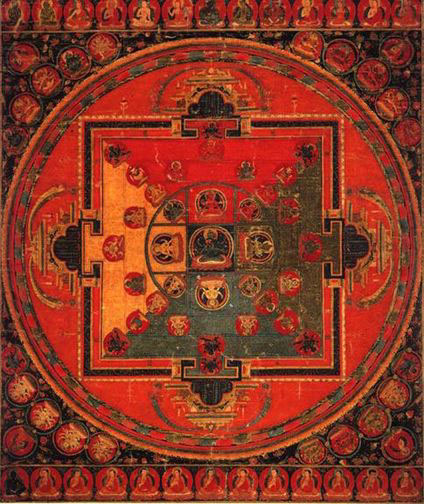| Mandala of an Esoteric Form of Manjusri Central Tibet, 14th century 65.5 x 53.5 cm |
|
At the center of this mandala is an esoteric deity whose precise identity is uncertain. The three-headed, six-armed god embraces his consort and holds a lotus and book, wheel (?), sword and an unidentified object. The sword and book, implements characte
ristic of Manjusri, the Mahayana bodhisattva of wisdom, suggest this might be an esoteric form of Manjusri. However, the iconography of this god and that of his entourage do not precisely correspond to known iconographic descriptions for Manjusri.1 Without an accompanying iconographic description, the identities of the other figures in the mandala are unclear. However, the outer assembly includes a standard group of protective deities: Yamantaka (E), Prajnantaka (S), Padmantaka (W), Vighnantaka (N) , Takkiraja (SE), Niladanda (SW), Mahabala (NW), Acala (NE), Usnisacakravartin (zenith; here, in the western gate), Sumbharaja (nadir; here, in the eastern gate). None of the historical figures are identified by inscription; their precise identities are therefore speculative. Indian mahasiddhas and Tibetan monks are represented, together with other deities associated with the teachings of this esoteric form of Man jusri's mandala. 1 See Mallmann, Manjusri, passim; and Bhattacharyya, The Indian Buddhist Iconography, passim. The iconography is similar, though not identical with that of Manjuvajra's mandala. See Mallmann, Introduction a l'iconographie du tantrisme bouddhique, pp. 42-43. |
